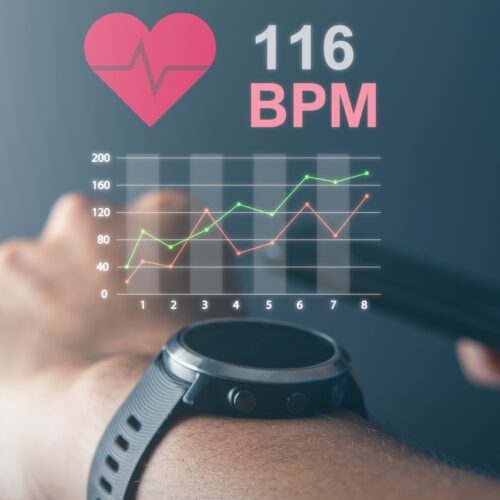Introduction: Why HRV Matters for Health
Heart Rate Variability (HRV) is gaining recognition as an essential measure of health and well-being, acting as a barometer for how well our bodies adapt to stress. Far beyond just tracking fitness levels, HRV provides insights into the balance between rest and stress, revealing how resilient our bodies are to life’s demands. For anyone seeking a better grasp of their overall wellness, understanding HRV is key because it acts as the body’s communication tool, providing a snapshot of mental, physical, emotional, and even spiritual stress loads.
A Brief History of HRV
HRV emerged as a health metric in the 1960s when scientists discovered its potential to assess heart health. Initially, HRV was used in medical contexts to monitor heart patients, with doctors observing that lower HRV often indicated poor heart function or vulnerability to adverse cardiac events. Today, wearables like the Oura Ring, Whoop, and Biostrap make HRV accessible to anyone, offering a real-time look at how our autonomic nervous system (ANS) responds to daily stressors.
The Science of HRV and How It’s Measured
HRV is a measure of the variation in time intervals between heartbeats, controlled by the autonomic nervous system. Specifically, it reflects the balance between the sympathetic nervous system (SNS), which drives the “fight or flight” response, and the parasympathetic nervous system (PNS), which promotes “rest and digest.” A high HRV indicates a responsive, adaptive system capable of shifting between states as needed, while low HRV suggests the body is under sustained stress or strain.
Medically, HRV is measured using an electrocardiogram (ECG or EKG) to capture precise heart data. Wearable devices, while less precise, use optical sensors to measure HRV over longer periods, offering users a general trend without needing medical equipment. Despite the slight variation, both medical and wearable HRV measurements provide valuable insights into stress, recovery, and overall health.
HRV: What It Is and What It Isn’t
What HRV Is:
- A Holistic Health Measure: HRV reflects more than physical exertion; it captures mental, emotional, and environmental stress, giving a comprehensive view of your overall stress load.
- A Decision-Making Tool: HRV data can guide how intensely you should train, when to rest, and when to prioritize recovery activities, helping you avoid burnout and promote balance.
- A Communication Tool: HRV serves as your body’s way of signaling how well it’s adapting to stress. A declining HRV may indicate that it’s time to prioritize rest, while a steady HRV suggests good adaptability.
- An Indicator of Autonomic Load: HRV shows the influence of the sympathetic (fight or flight) and parasympathetic (rest and digest) nervous systems, helping you understand your body’s current state.
- Insight into Stress Adaptation: Rather than merely showing stress, HRV reveals how well your body is adapting, helping you respond in ways that promote resilience and health.
What HRV Is Not:
- A Performance Predictor: A high HRV doesn’t guarantee you’ll perform better, and a low HRV doesn’t mean you’ll underperform. It’s a measure of recovery potential, not output.
- Not Heart Rate: HRV measures the variability between heartbeats, not the beats per minute. A high HRV can correlate with a lower heart rate but isn’t the same thing.
- Not Only Physical Stress: While physical activity affects HRV, mental, emotional, and lifestyle factors (like sleep quality) play equally crucial roles.
- Not a Judgment on Stress: HRV doesn’t label stress as “good” or “bad”; it only reflects how the body is responding, providing data to make informed decisions.
- Not a Static Metric: HRV changes throughout the day and is influenced by various factors, so it’s best viewed as a trend over time rather than a single value.
How HRV Connects to Your Health
HRV’s connection to health is profound, as it reflects the body’s readiness to take on challenges. A higher HRV is generally associated with better cardiovascular health, greater resilience, and effective recovery, while lower HRV can signal overtraining, illness, or a need for rest. With that being said, HRV is highly individualized. Your HRV is unique to you, influenced by genetics, fitness level, lifestyle, and daily habits. It’s essential to track your own HRV trends over time rather than comparing them with others. What matters most is how your HRV fluctuates relative to your own baseline, indicating how well your body is recovering and adapting to stress. By tuning into HRV trends, you gain insights into your daily recovery needs, helping you make proactive adjustments to protect your long-term health.
Ways to Improve HRV (and What Hurts It Most)
Ways to Improve HRV:
- Consistent Sleep: Prioritize 7-9 hours per night and maintain a consistent schedule to improve HRV.
- Regular Exercise: Gentle aerobic exercise, like walking or cycling, supports cardiovascular health and promotes higher HRV.
- Mindfulness Practices: Meditation, yoga, and breathing exercises activate the parasympathetic nervous system, enhancing HRV.
- Hydration and Nutrition: Staying hydrated and eating nutrient-dense foods can positively impact HRV by supporting cellular health.
- Manage Caffeine and Alcohol: Both substances can lower HRV, so consume them in moderation.
What Hurts HRV:
- Poor Sleep: Inconsistent or insufficient sleep drastically lowers HRV by taxing the autonomic nervous system.
- Chronic Stress: Constant, unmanaged stress can keep the body in a prolonged “fight or flight” mode, reducing HRV.
- Overtraining: Intense physical activity without sufficient recovery time places excess stress on the body, leading to low HRV.
- Sedentary Lifestyle: Lack of movement can contribute to poor cardiovascular health and lower HRV.
- Unbalanced Diet: Diets high in processed foods and low in nutrients can negatively impact HRV and overall heart health.
Conclusion: Why HRV Matters and How to Use It
HRV is a valuable tool for assessing how well your body adapts to the many demands placed on it. Viewing HRV as your body’s unique communication method gives you insights into its needs and responses. Regularly tracking HRV helps you make informed choices about rest, activity, and lifestyle habits, empowering you to live more in tune with your body’s natural rhythms. HRV is a reflection of how well you’re managing stress, balancing recovery, and building resilience over time. By listening to and learning from this data, you’ll be better equipped to make decisions and build habits that support a healthier, more balanced life.
Sources:
- Malik M, Camm AJ, Thomas M, et al. “Heart Rate Variability: Standards of Measurement, Physiological Interpretation, and Clinical Use.” European Heart Journal. 1996.
- Shaffer F, Ginsberg JP. “An Overview of Heart Rate Variability Metrics and Norms.” Frontiers in Public Health. 2017.
- Goldstein DS, Kopin IJ. “Evolution of concepts on the pathophysiology of essential hypertension.” American Journal of Physiology-Regulatory, Integrative and Comparative Physiology. 2011.








